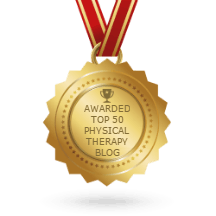The best part about content marketing is its versatility. It can be specific to your practice, free and really covering any topic you want it to be, plus it’s easy for beginners to get started.
That said, not every aspect of creating content is easy. A successful content marketing campaign for your physical therapy clinic must deliver a valuable message, and consistently define you and your practice as the leader in your community.
One aspect of keeping your post evergreen is to revisit your blog history, we’re talking about the maintenance of your previous content marketing. Updating older content is a great way to boost your SEO, but many practice owners and marketers don’t take advantage of this opportunity.
Here’s why that should change.

Physical Therapy Content’s Final Stage
Content creation involves a defined process and repeated stages that begin with research. From there, the plan is formed to make new content over time. Once the content is designed or written, it’s published and shared, with not much done after the fact.
But the time after publishing, the maintenance phase is vital. Unfortunately, in the fury of constantly pushing new content, the end of this process is often neglected.
The content you’ve created to provide long-term value — your evergreen content — plays an important role in your site. These pieces are designed to stay relevant over time and guide new patients to your clinic, so they shouldn’t be neglected.
- Just think about some of the benefits evergreen content brings to the table:
- Driving traffic.
- Backlinking.
- Authoritative keywords.
- Site and content continuity.
- Improved ranking.
Evergreen and constantly maintained pieces serve as a foundation for the rest of your content and grow your authority as the leading physical therapist of your area. This also alleviates the stress of constantly struggling to source or validate new content.
Maintenance doesn’t have the urgency of creation, however, so it tends to take the back burner in content marketing. Content maintenance is about nurturing a sustainable relationship with your growing audience by keeping your post reliable.
If a loyal patient were to stumble upon an old, outdated post, they may lose faith in your practice.
Content maintenance is challenging though, which is why many content marketers ignore it. Evergreen content requires time, research and updates to stay relevant, which means adding a second plan in addition to your content marketing strategy.
Here are some methods you can use to update and maintain older content:

Physical Therapy Blog Technical Updates
Like anything else, your site needs maintenance over time. Whether it’s broken links or an outdated background, technical issues are likely present in your old content.
Even if it was published in peak condition at the time, there will likely be one or more elements that should be updated.
For example, Google recently made changes to their meta descriptions. The previous limitation of 160 characters is no longer the case, so what was once optimized is no longer optimized.
Maybe your meta description still works for SEO today, but it’s still worth the time to refresh your old content and check for things like this.
You may also want to experiment with new title tags to boost engagement and refresh your post. You may find that you have broken links or links to outdated resources that are no relevant which harms your credibility.
Broken links hurt your SEO, so take the time to find newer information or statistics that emphasize your point and link to those. You can also update your “last updated” timestamp to show viewers that your content is fresh.
Another technical challenge is the way content is consumed now versus how it was consumed years ago. The end of Flash, for instance, has also ended plenty of excellent content pieces that relied upon it. If you created content with Flash, it won’t last much longer as Flash is being phased out. Many sites recommend Flash be disabled anyway, so it’s a change that will come no matter what.
A way to update that content for modern audiences is by switching out JPEG images for PNG images. PNG images have better quality and load times than JPEG images, so if you don’t update them, you may find that you have slower load times that impact your SEO.
Revitalize Your Most Popular Old Physical Therapy Posts
While maintenance is important, you don’t need to update every single piece of old content, nor should you. The best place to start with updates is with your best and most popular pieces, regardless of how old they may be.
You can find out what these pieces are with Google Analytics under the “Behavior” section. This section will show you a detailed breakdown of each page’s performance for the history of your site and the posts that have stayed popular over the years. You’ll then have a list of pieces that are worth maintaining.
If you focus on maintaining and revitalizing these older pieces of popular content, you’ll most likely be able to continue to leverage them in the future.
You may also want to consider why these content pieces have been so successful. Each piece of content has a purpose, so you may learn more about what works and what doesn’t by analyzing your popular pieces.
If you think that an older piece could do better, consider “upcycling.” Upcycling turns your old pieces into a new format, which is commonly done with a video. It’s the same information, but it’s presented in a way that revitalizes the content and gets it more attention.

Make Relevance about your Physical Therapy Private Practice a New Goal
No matter how evergreen you thought your content was, time will always make your posts irrelevant. Eventually, posts will turn into old news, which requires maintenance to keep them relevant.
One of the benefits here, however, is that you can turn your piece into something noteworthy with your new perspective. So, instead of focusing on updating the piece for popularity, focus on making changes to make it more relevant.
To start, evaluate your content according to three questions:
- Does your content still pique interest?
- Is it timely?
- Will it provide a purpose to your patients and your practice?
If the answer to all three of these questions is yes, then you have content that’s worth updating.
The most relevant content will be viewed and shared more, so taking the time to revamp your relevant content can improve your content lifecycle.
Once you decide that the piece should and could be updated, it’s a good idea to check the topic with Google Trends to make sure there’s interest in the topic of the old post you’ve chosen to update. If you see too many peaks and valleys, you may want to wait until the optimal time to revamp your piece.
Final Thoughts
Content maintenance isn’t the most exciting part of developing a content marketing strategy, but it’s incredibly helpful for your practice. If you want to continue to create evergreen content, you need to put in the effort to reach your patients.
This means taking the time with your old blog posts and checking for technical issues, popularity and relevance to see what will work best. It also means making a serious commitment to making these changes.
Evergreen content isn’t designed for overnight success. Instead, it takes up a vital place in your content library that will bring traffic and credibility to your brand for years.













